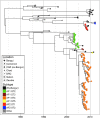Revealing the Micro-scale Signature of Endemic Zoonotic Disease Transmission in an African Urban Setting
- PMID: 27058957
- PMCID: PMC4825935
- DOI: 10.1371/journal.ppat.1005525
Revealing the Micro-scale Signature of Endemic Zoonotic Disease Transmission in an African Urban Setting
Abstract
The development of novel approaches that combine epidemiological and genomic data provides new opportunities to reveal the spatiotemporal dynamics of infectious diseases and determine the processes responsible for their spread and maintenance. Taking advantage of detailed epidemiological time series and viral sequence data from more than 20 years reported by the National Reference Centre for Rabies of Bangui, the capital city of Central African Republic, we used a combination of mathematical modeling and phylogenetic analysis to determine the spatiotemporal dynamics of rabies in domestic dogs as well as the frequency of extinction and introduction events in an African city. We show that although dog rabies virus (RABV) appears to be endemic in Bangui, its epidemiology is in fact shaped by the regular extinction of local chains of transmission coupled with the introduction of new lineages, generating successive waves of spread. Notably, the effective reproduction number during each wave was rarely above the critical value of 1, such that rabies is not self-sustaining in Bangui. In turn, this suggests that rabies at local geographic scales is driven by human-mediated dispersal of RABV among sparsely connected peri-urban and rural areas as opposed to dispersion in a relatively large homogenous urban dog population. This combined epidemiological and genomic approach enables development of a comprehensive framework for understanding disease persistence and informing control measures, indicating that control measures are probably best targeted towards areas neighbouring the city that appear as the source of frequent incursions seeding outbreaks in Bangui.
Conflict of interest statement
The authors have declared that no competing interests exist.
Figures




References
-
- Anderson RM, Jackson HC, May RM, Smith AM (1981) Population dynamics of fox rabies in Europe. Nature 289: 765–771. - PubMed
Publication types
MeSH terms
Grants and funding
LinkOut - more resources
Full Text Sources
Other Literature Sources
Medical

